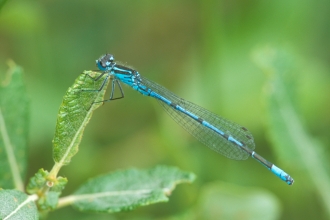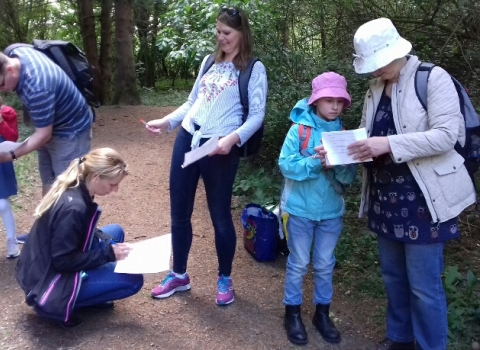
Ufton Fields
Introduction
Ufton Fields has a wonderful array of different habitats including pools, marshes, grassland and woodland. A circular, waymarked trail provides excellent access to all this fantastic reserve has to offer. Look out for feature points and see what you can discover about this special place and its wildlife.
About the Reserve
Quarried for White Lias Limestone in the 1950’s, low spoil heaps were dumped forming a series of ridges, separated by deep furrows. Fast growing, non-native trees were then planted, the furrows filled with water and nature did the rest. The 31 hectare (78 acre) site was declared as a Site of Special Scientific Interest (SSSI) and gifted to Warwickshire County Council in 1972. Plants thrive on the lime rich soil, bird life is diverse and invertebrates prosper, truly meriting its special status. The reserve is managed by Warwickshire Wildlife Trust to ensure the diversity of habitats remain.
Things to see
Ufton Fields is the most northern place in the UK where the rare Man Orchid can be found. It is also important for wildflowers, fungi, butterflies, birds and a variety of water life including toads, newts, dragonflies and damselflies.
Things to do
- Walk - A circular, way marked trail takes visitors around a two kilometre (1.25 mile) loop, taking up to an hour.
- Pause – Feature stops dotted around the reserve in areas of high ecological or geological significance act as a reminder to pause, look and listen.
- Touch - Brass rubbing disks featuring local wildlife are attached to each way marker post.
- Look – Two easy access bird hides provide opportunity see birds and dragonflies.
- Eat – The reserve offers a number of picnic spots so why not stay a little longer and enjoy the sights and sounds of nature.
Waymarked Trail
1. Alder Leaf brass rubbing disk
From the main information board in the car park, turn left toward the gate. Follow the path along Alder Pool. Alder Pool is named after the Alder Trees which line its banks. Alder is the only British native deciduous, or broadleaf, tree to develop cones. These cones are the female catkins, which stay on the tree year round. Can you spot them in the canopy above or on the ground?
2. Great Spotted Woodpecker brass rubbing disk
Continue walking straight ahead, away from the pool towards a meadow area known as ‘The Ridges’, to continue the trail. Keep an ear out for Great Spotted Woodpecker in the trees above. Great spotted woodpeckers nest in holes which they excavate in trees, in mainly deciduous or broadleaf trees. They have a distinctive bouncing flight but are most likely to be heard ‘drumming’ away at a tree trunk. Great spotted woodpeckers probe tree trunks for insects and larvae to eat; they have extremely sticky tongues enabling them to extract the insects from their nests. In autumn and winter they will switch to eating berries and nuts and will visit peanut feeders hung in gardens.

Credit Kathleen Everitt
3. Grass snake brass rubbing disk
From the way marker, follow the path along the boundary hedge past as meadow area known as ‘The Ridges’. Ufton Fields lies about 110 metres above sea level on the band of white Lias limestone which runs from near Stratford-upon-Avon, to Wigston in Leicestershire. These rocks are overlain by lower Lias clay, in the form of shales and mudstones. The area was once quarried for limestone and the ‘The Ridges’ were formed during excavation. Topsoil was removed to expose the underlying rock and deposited on areas which had already been quarried creating these ridge formations. Topsoil was covered by the rest of the overburden and consequently the ridges are composed of a nutrient deficient soil, visible in this aerial photograph from 1945.
Prior to quarrying, the site was farmland and fragments of this remain within the reserve, indicated by the presence of Elm in places and remnants of hedgerows. When quarrying ceased in 1955, a large area of the reserve was planted with non-native, fast growing tree species to screen the landscape and over time interesting calcareous grassland communities have developed. We now manage the reserve in the interest of nature conservation, enhancing the diverse habitats the reserve now boasts. Our largest snake, the Grass Snake, particularly likes wetland habitats, but can also be found in dry grasslands.
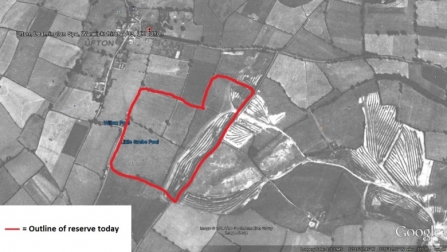
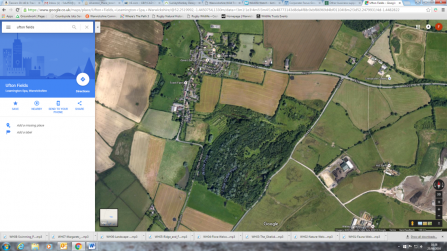
Credit Google maps
4. Common Toad brass rubbing disk
From the way marker, you might walk the short trail to the hide which offers views over Horseshoe Pool, before returning to the circular trail. The bird life is very diverse, with flocks of tits and finches enjoying the reserve, along with migrant warblers and spotted flycatcher. Dense scrub provides cover for winter thrushes.
Water life is abundant, with caddisfly larvae, leeches and water-scorpions all to be found lurking in the pools. Common toads breed year on year, producing thousands of toadlets in late spring. Smooth and great crested newts exist in many of the pools and look out for grass snakes swimming here.
Alternatively, continue along the main path to way marker 5.
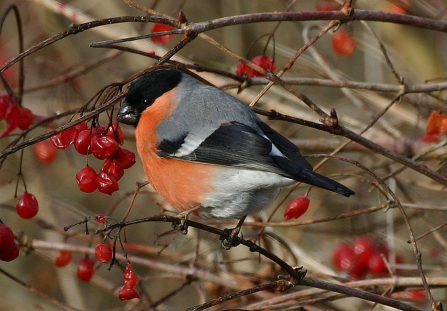
Credit A. Wincott
Credit Philip Precey
5. Common pipistrelle brass rubbing disk
From the way marker, the path bends to the right. Further along, a feature post should draw your interest to a recently exposed lias limestone outcrop. From the path, look down the bank to the right to see the area exposed by the Warwickshire Geological Conservation Group (WGCG). This bed was left unused when quarrying finished. You can see the edge of the bed facing you – it is a pale cream colour, breaks up into blocks and is about 50cm thick. The flat top of the bed runs away to the left under the bushes. For the quarrymen to get at the limestone they had to remove a bed of dark grey muddy shale. You are standing on top of that bed and should be able to see some of the clay on the side of the path. The clay was dumped in the ridges which run across the reserve. Both the limestone and the shale were laid down about 200 million years ago in a shallow tropical sea. Much of this limestone in Warwickshire has been quarried and the outcrop at Ufton Fields is one of the very few still preserved. The pub, the church and most of the old cottages in Ufton are built using the cream-coloured limestone.
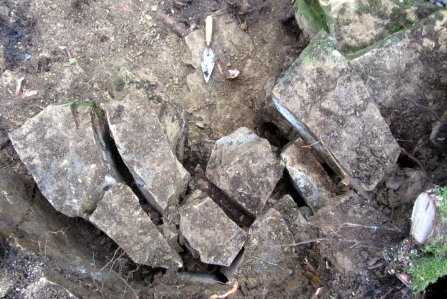
Credit Brian Ellis
6. Speckled Wood brass rubbing disk
From the way marker, follow the path round to the right. In this part of the reserve the overburden from excavation activities was removed but the underlying limestone was found to be too shallow to warrant its removal therefore the area has a thin layer of free-draining sandy soil overlying limestone and is the botanically richest part of the reserve. The reserve has a vast array of flowers, including cowslip, wild basil and five species of Orchid, including the colourful bee orchid.
Flower rich grasslands and sheltered conditions are ideal condition for the twenty eight species of butterflies recorded at Ufton Fields.
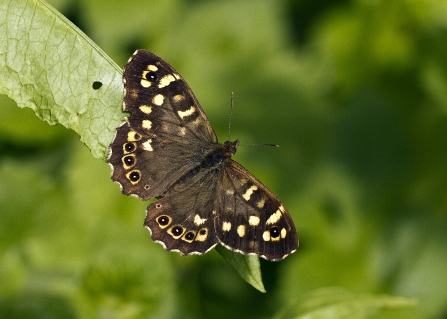
Credit Friends of the River Arrow
7. Broad bodied chaser brass rubbing disk
Continue along the path towards the second hide. This hide, overlooking Dragonfly Pool, forms the oldest part of the quarry and is an excellent place to look for dragonflies, damselflies and birds. Invertebrates prosper at Ufton Fields and were indeed the main reason for its SSSI (Site of Special Scientific Interest) designation, with 41 species that are nationally scarce, including 14 species of dragonfly and damselfly.
We even had a family of visiting Otters in February 2016!
8. Little Grebe brass rubbing disk
Leaving the hide, continue along the trail. Following quarrying activity, excavation was hidden behind fast-growing, non-native trees, whilst most of the site was left to recolonise naturally. As a result, the woodland still contains hybrid poplar, grey alder and conifers. In 2015/2016, some of the conifers were removed to allow light down onto the forest floor in order to allow native species to thrive. However, the conifers are one of the distinguishing features of Ufton Fields and add to the rich variety of habitats here. The presence of the conifers is also justified by their associated fungi.
Continue along the trail towards Little Grebe Pool. Looking down the length of the reserves largest pool provides one of the most spectacular views. The muddy margins of the pool provide suitable feeding conditions for invertebrates and wading birds. Little grebe and teal occupy the pools, with perhaps a passage common sandpiper feeding at the pool margins. Buzzard, kestrel and sparrow hawk hunt the reserve, whilst green woodpeckers search the grassland for ants.
The Little Grebe is a small bird with a ‘fluffy rear end’. They dive frequently for fish and aquatic invertebrates. In the summer months adults have a brown plumage with a striking chestnut neck and cheeks. Its presence is easiest to detect by listening for its distinctive call. Look at the vegetation at the sides of the pool for sightings.
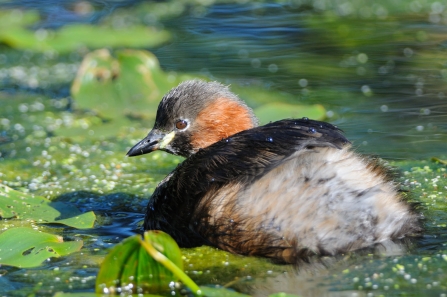
Credit Steven Cheshire
9. Fly Agaric brass rubbing disk
As the trail continues past Willow Pool keep a close eye out for lichens and fungi. The range of different habitats at Ufton Fields encourages a wide variety of different fungi. Often thought of as plants, fungi are in a kingdom all of their own. There are at least 70,000 species worldwide, approximately 12,000 in the UK
Lichens can be confused for moss but lichens are not in fact plants. They are the result of a symbiotic relationship between a fungus and algi, meaning the relationship allows both organisms to live well. Lichens can be found encrusted on the bark of trees, and are important due to their sensitivity to pollution. As a result they are considered ‘bio indicators’ and will respond in a clear way to changes in the environment, especially air pollution, as they derive their water and essential nutrients mainly from the atmosphere rather than the soil. Lichens come in all different shapes, sizes and colours. Can you spot any lichens on the trees around here?
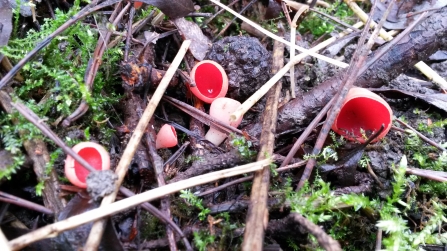
Print off a copy of the Ufton Fields wild walk route to take with you
How can I help?
We're running fortnightly hands-on practical sessions at Ufton Fields to encourage local people to get out and get active. If you fancy trying something new, meeting like-minded people and being active, outdoors find out more here or contact us on volunteer@wkwt.org.uk to find out more.

